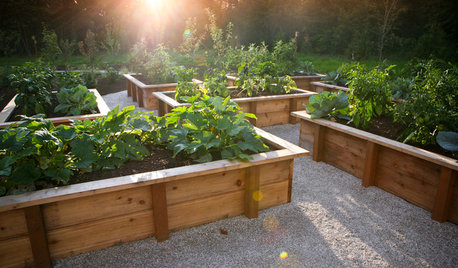How to use this material for a raised bed mix?
joeworm
12 years ago
Related Stories

GARDENING AND LANDSCAPINGBuild a Raised Bed to Elevate Your Garden
A bounty of homegrown vegetables is easier than you think with a DIY raised garden bed to house just the right mix of soils
Full Story
GARDENING GUIDES8 Materials for Raised Garden Beds
Get the dirt on classic and new options for raised vegetable and plant beds, to get the most from your year-round garden
Full Story
FARM YOUR YARDHow to Build a Raised Bed for Your Veggies and Plants
Whether you’re farming your parking strip or beautifying your backyard, a planting box you make yourself can come in mighty handy
Full Story
KITCHEN DESIGNNew This Week: 2 Kitchens That Show How to Mix Materials
See how these kitchens combine textures, colors and materials into a harmonious whole
Full Story
GARDENING AND LANDSCAPINGRaised Beds Lift Any Garden
From good old-fashioned wood garden boxes to modern metal troughs, raised beds can make any landscape space look great
Full Story
SPRING GARDENINGInspiring Raised Beds for Fall and Spring Planting
Make Your Next Vegetable Garden Even Better with Beautiful Boxes and Paths
Full Story
BARN HOMES12 Bar-Raising Barns
Homeowners make hay out of renovated, reclaimed and newly raised outbuildings
Full Story
ACCESSORIESFinish Your Look With a Fun Mix of Textiles
Why box yourself into a design corner when you can spread out ever-changing throws, rugs and even bags?
Full Story
HOUZZ TOURSMy Houzz: Mixed-Use Oregon Home Serves and Charms
Home, restaurant, garden, rental cabin — and it gives back to the community too. This multitasking home is a wonder in more ways than one
Full Story
CONTEMPORARY HOMESHouzz Tour: Unusual Mixes of Old and New in Texas
Modern touches done in surprising ways give a traditional Austin house a whole new personality
Full Story







tapla (mid-Michigan, USDA z5b-6a)
joewormOriginal Author
Related Professionals
Lowell Landscape Architects & Landscape Designers · Montgomeryville Landscape Architects & Landscape Designers · Rancho Cordova Landscape Architects & Landscape Designers · Biloxi Landscape Contractors · Parkland Landscape Contractors · Paterson Landscape Contractors · Silver Firs Landscape Contractors · Coral Gables Window Contractors · Hudson Window Contractors · Marshfield Window Contractors · Matteson Window Contractors · Muncie Window Contractors · Carmichael Fence Contractors · Manorville Fence Contractors · Pasadena Fence Contractorstapla (mid-Michigan, USDA z5b-6a)
joewormOriginal Author
tapla (mid-Michigan, USDA z5b-6a)
joewormOriginal Author
tapla (mid-Michigan, USDA z5b-6a)
joewormOriginal Author
tapla (mid-Michigan, USDA z5b-6a)
joewormOriginal Author
tapla (mid-Michigan, USDA z5b-6a)